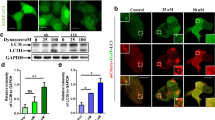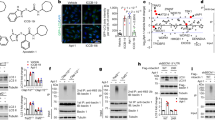Abstract
Poly-ubiquitinated protein aggregate formation is the most striking hallmark of various neurodegenerative diseases such as Alzheimer’s disease, Huntington’s disease, amyotrophic lateral sclerosis, and prion disease. Mutations of many ubiquitin-associated proteins involved in the regulation of protein aggregation, such as SQSTM1/p62 (p62), parkin, and VCP, are closely linked to neurodegeneration. B-cell lymphoma 2 (Bcl-2) is a key regulator in autophagy, apoptosis, and mitochondria quality control in many cell types including neurons, and it plays important roles in the pathogenesis of neurodegenerative diseases mentioned above. Our previous work showed that Bcl-2 can directly bind to p62, and here we report that Bcl-2 directly interacts with the N-terminus of p62, but not the C-terminus (UBA domain). Interestingly and importantly, Bcl-2 affects the affinity of p62 to poly-ubiquitin chains and suppresses the aggregation of poly-ubiquitinated proteins such as mutant huntingtin associated with Huntington’s disease. Our study reveals a role of Bcl-2 that involves in the regulation of misfolded proteins.





Similar content being viewed by others
References
Rubinsztein DC (2006) The roles of intracellular protein-degradation pathways in neurodegeneration. Nature 443(7113):780–786. doi:10.1038/nature05291
Ross CA, Poirier MA (2005) Opinion: what is the role of protein aggregation in neurodegeneration? Nat Rev Mol Cell Biol 6(11):891–898. doi:10.1038/nrm1742
Ross CA, Poirier MA (2004) Protein aggregation and neurodegenerative disease. Nat Med 10:S10–S17. doi:10.1038/nm1066
Kim SH, Shi Y, Hanson KA, Williams LM, Sakasai R, Bowler MJ, Tibbetts RS (2009) Potentiation of amyotrophic lateral sclerosis (ALS)-associated TDP-43 aggregation by the proteasome-targeting factor, ubiquilin 1. J Biol Chem 284(12):8083–8092. doi:10.1074/jbc.M808064200
Olzmann JA, Li L, Chudaev MV, Chen J, Perez FA, Palmiter RD, Chin LS (2007) Parkin-mediated K63-linked polyubiquitination targets misfolded DJ-1 to aggresomes via binding to HDAC6. J Cell Biol 178(6):1025–1038
Sha Y, Pandit L, Zeng S, Eissa NT (2009) A critical role for CHIP in the aggresome pathway. Mol Cell Biol 29(1):116–128
Bruijn LI, Houseweart MK, Kato S, Anderson KL, Anderson SD, Ohama E, Reaume AG, Scott RW, Cleveland DW (1998) Aggregation and motor neuron toxicity of an ALS-Linked SOD1 mutant independent from wild-type SOD1. Science 281(5384):1851–1854. doi:10.1126/science.281.5384.1851
Kalchman MA, Graham RK, Xia G, Koide HB, Hodgson JG, Graham KC, Goldberg YP, Gietz RD, Pickart CM, Hayden MR (1996) Huntingtin is ubiquitinated and interacts with a specific ubiquitin-conjugating enzyme. J Biol Chem 271(32):19385–19394
Paulson HL, Perez MK, Trottier Y, Trojanowski JQ, Subramony SH, Das SS, Vig P, Mandel JL, Fischbeck KH, Pittman RN (1997) Intranuclear inclusions of expanded polyglutamine protein in spinocerebellar ataxia type 3. Neuron 19(2):333–344
Ying Z, Wang H, Wang G (2013) The ubiquitin proteasome system as a potential target for the treatment of neurodegenerative diseases. Curr Pharm Des 19(18):3305–3314
Kuusisto E, Parkkinen L, Alafuzoff I (2003) Morphogenesis of Lewy bodies: dissimilar incorporation of alpha-synuclein, ubiquitin, and p62. J Neuropathol Exp Neurol 62(12):1241–1253
Zatloukal K, Stumptner C, Fuchsbichler A, Heid H, Schnoelzer M, Kenner L, Kleinert R, Prinz M, Aguzzi A, Denk H (2002) p62 is a common component of cytoplasmic inclusions in protein aggregation diseases. Am J Pathol 160(1):255–263. doi:10.1016/S0002-9440(10)64369-6
Gal J, Strom AL, Kilty R, Zhang F, Zhu H (2007) p62 accumulates and enhances aggregate formation in model systems of familial amyotrophic lateral sclerosis. J Biol Chem 282(15):11068–11077. doi:10.1074/jbc.M608787200
Kuusisto E, Salminen A, Alafuzoff I (2002) Early accumulation of p62 in neurofibrillary tangles in Alzheimer’s disease: possible role in tangle formation. Neuropathol Appl Neurobiol 28(3):228–237
Nagaoka U, Kim K, Jana NR, Doi H, Maruyama M, Mitsui K, Oyama F, Nukina N (2004) Increased expression of p62 in expanded polyglutamine-expressing cells and its association with polyglutamine inclusions. J Neurochem 91(1):57–68. doi:10.1111/j.1471-4159.2004.02692.x
Seidel K, den Dunnen WF, Schultz C, Paulson H, Frank S, de Vos RA, Brunt ER, Deller T, Kampinga HH, Rub U (2010) Axonal inclusions in spinocerebellar ataxia type 3. Acta Neuropathol 120(4):449–460. doi:10.1007/s00401-010-0717-7
Kirkin V, McEwan DG, Novak I, Dikic I (2009) A role for ubiquitin in selective autophagy. Mol Cell 34(3):259–269. doi:10.1016/j.molcel.2009.04.026
Moscat J, Diazmeco M, Wooten M (2007) Signal integration and diversification through the p62 scaffold protein. Trends Biochem Sci 32(2):95–100. doi:10.1016/j.tibs.2006.12.002
Saio T, Yokochi M, Inagaki F (2009) The NMR structure of the p62 PB1 domain, a key protein in autophagy and NF-κB signaling pathway. J Biomol NMR 45(3):335–341. doi:10.1007/s10858-009-9370-7
Nakamura K, Kimple AJ, Siderovski DP, Johnson GL (2010) PB1 domain interaction of p62/sequestosome 1 and MEKK3 regulates NF-κB activation. J Biol Chem 285(3):2077–2089. doi:10.1074/jbc.M109.065102
Pankiv S, Clausen TH, Lamark T, Brech A, Bruun JA, Outzen H, Overvatn A, Bjorkoy G, Johansen T (2007) p62/SQSTM1 binds directly to Atg8/LC3 to facilitate degradation of ubiquitinated protein aggregates by autophagy. J Biol Chem 282(33):24131–24145. doi:10.1074/jbc.M702824200
Tung YT, Hsu WM, Lee H, Huang WP, Liao YF (2010) The evolutionarily conserved interaction between LC3 and p62 selectively mediates autophagy-dependent degradation of mutant huntingtin. Cell Mol Neurobiol 30(5):795–806. doi:10.1007/s10571-010-9507-y
Seibenhener ML, Babu JR, Geetha T, Wong HC, Krishna NR, Wooten MW (2004) Sequestosome 1/p62 is a polyubiquitin chain binding protein involved in ubiquitin proteasome degradation. Mol Cell Biol 24(18):8055–8068. doi:10.1128/mcb.24.18.8055-8068.2004
Teyssou E, Takeda T, Lebon V, Boillée S, Doukouré B, Bataillon G, Sazdovitch V, Cazeneuve C, Meininger V, LeGuern E, Salachas F, Seilhean D, Millecamps S (2013) Mutations in SQSTM1 encoding p62 in amyotrophic lateral sclerosis: genetics and neuropathology. Acta Neuropathol 125(4):511–522. doi:10.1007/s00401-013-1090-0
Hiruma Y, Kurihara N, Subler MA, Zhou H, Boykin CS, Zhang H, Ishizuka S, Dempster DW, Roodman GD, Windle JJ (2008) A SQSTM1/p62 mutation linked to Paget’s disease increases the osteoclastogenic potential of the bone microenvironment. Hum Mol Genet 17(23):3708–3719. doi:10.1093/hmg/ddn266
Cavey JR, Ralston SH, Hocking LJ, Sheppard PW, Ciani B, Searle MS, Layfield R (2005) Loss of ubiquitin-binding associated with Paget’s disease of bone p62 (SQSTM1) mutations. J Bone Min Res Off J Am Soc Bone Min Res 20(4):619–624. doi:10.1359/jbmr.041205
Green JC, Reed DR (1998) Mitochondria and apoptosis. Science 281(5381):1309–1312. doi:10.1126/science.281.5381.1309
Yang J (1997) Prevention of apoptosis by Bcl-2: release of cytochrome c from mitochondria blocked. Science 275(5303):1129–1132
Wei Y, Pattingre S, Sinha S, Bassik M, Levine B (2008) JNK1-mediated phosphorylation of Bcl-2 regulates starvation-induced autophagy. Mol Cell 30(6):678–688. doi:10.1016/j.molcel.2008.06.001
Pattingre S, Tassa A, Qu X, Garuti R, Liang XH, Mizushima N, Packer M, Schneider MD, Levine B (2005) Bcl-2 antiapoptotic proteins inhibit Beclin 1-dependent autophagy. Cell 122(6):927–939. doi:10.1016/j.cell.2005.07.002
Sassone J, Maraschi A, Sassone F, Silani V, Ciammola A (2013) Defining the role of the Bcl-2 family proteins in Huntington’s disease. Cell Death Dis 4:e772. doi:10.1038/cddis.2013.300
Jana NR, Zemskov EA, Wang G, Nukina N (2001) Altered proteasomal function due to the expression of polyglutamine-expanded truncated N-terminal huntingtin induces apoptosis by caspase activation through mitochondrial cytochrome c release. Hum Mol Genet 10(10):1049–1059
Wong E, Cuervo AM (2010) Autophagy gone awry in neurodegenerative diseases. Nat Neurosci 13(7):805–811. doi:10.1038/nn.2575
Bjorkoy G, Lamark T, Brech A, Outzen H, Perander M, Overvatn A, Stenmark H, Johansen T (2005) p62/SQSTM1 forms protein aggregates degraded by autophagy and has a protective effect on huntingtin-induced cell death. J Cell Biol 171(4):603–614. doi:10.1083/jcb.200507002
Shvets E, Fass E, Scherz-Shouval R, Elazar Z (2008) The N-terminus and Phe52 residue of LC3 recruit p62/SQSTM1 into autophagosomes. J Cell Sci 121(16):2685–2695. doi:10.1242/jcs.026005
Zhou L, Wang H-f, Ren H-g, Chen D, Gao F, Hu Q-s, Fu C, Xu R-j, Ying Z, Wang G-h (2013) Bcl-2-dependent upregulation of autophagy by sequestosome 1/p62 in vitro. Acta pharmacologica Sinica
Chen D, Gao F, Li B, Wang H, Xu Y, Zhu C, Wang G (2010) Parkin mono-ubiquitinates Bcl-2 and regulates autophagy. J Biol Chem 285(49):38214–38223. doi:10.1074/jbc.M110.101469
Korolchuk VI, Mansilla A, Menzies FM, Rubinsztein DC (2009) Autophagy inhibition compromises degradation of ubiquitin-proteasome pathway substrates. Mol Cell 33(4):517–527. doi:10.1016/j.molcel.2009.01.021
Itakura E, Mizushima N (2011) p62 targeting to the autophagosome formation site requires self-oligomerization but not LC3 binding. J Cell Biol 192(1):17–27. doi:10.1083/jcb.201009067
Seibenhener ML, Babu JR, Geetha T, Wong HC, Krishna NR, Wooten MW (2004) Sequestosome 1/p62 is a polyubiquitin chain binding protein involved in ubiquitin proteasome degradation. Mol Cell Biol 24(18):8055–8068. doi:10.1128/MCB.24.18.8055-8068.2004
Lamark T, Perander M, Outzen H, Kristiansen K, Overvatn A, Michaelsen E, Bjorkoy G, Johansen T (2003) Interaction codes within the family of mammalian Phox and Bem1p domain-containing proteins. J Biol Chem 278(36):34568–34581. doi:10.1074/jbc.M303221200
Matsumoto G, Wada K, Okuno M, Kurosawa M, Nukina N (2011) Serine 403 phosphorylation of p62/SQSTM1 regulates selective autophagic clearance of ubiquitinated proteins. Mol Cell 44(2):279–289. doi:10.1016/j.molcel.2011.07.039
Isogai S, Morimoto D, Arita K, Unzai S, Tenno T, Hasegawa J, Sou YS, Komatsu M, Tanaka K, Shirakawa M, Tochio H (2011) Crystal structure of the ubiquitin-associated (UBA) domain of p62 and its interaction with ubiquitin. J Biol Chem 286(36):31864–31874. doi:10.1074/jbc.M111.259630
Tien CL, Wen FC, Hsieh M (2008) The polyglutamine-expanded protein ataxin-3 decreases bcl-2 mRNA stability. Biochem Biophys Res Commun 365(2):232–238. doi:10.1016/j.bbrc.2007.10.162
Tsai HF, Tsai HJ, Hsieh M (2004) Full-length expanded ataxin-3 enhances mitochondrial-mediated cell death and decreases Bcl-2 expression in human neuroblastoma cells. Biochem Biophys Res Commun 324(4):1274–1282. doi:10.1016/j.bbrc.2004.09.192
Williams AJ, Paulson HL (2008) Polyglutamine neurodegeneration: protein misfolding revisited. Trends Neurosci 31(10):521–528. doi:10.1016/j.tins.2008.07.004
Ilieva H, Polymenidou M, Cleveland DW (2009) Non-cell autonomous toxicity in neurodegenerative disorders: ALS and beyond. J Cell Biol 187(6):761–772. doi:10.1083/jcb.200908164
Taylor JP, Hardy J, Fischbeck KH (2002) Toxic proteins in neurodegenerative disease. Science 296(5575):1991–1995. doi:10.1126/science.1067122
Temussi PA, Masino L, Pastore A (2003) From Alzheimer to Huntington: why is a structural understanding so difficult? EMBO J 22(3):355–361. doi:10.1093/emboj/cdg044
Brady OA, Meng P, Zheng Y, Mao Y, Hu F (2011) Regulation of TDP-43 aggregation by phosphorylation and p62/SQSTM1. J Neurochem 116(2):248–259. doi:10.1111/j.1471-4159.2010.07098.x
Jana NR, Tanaka M, Wang G-h, Nukina N (2000) Polyglutamine length-dependent interaction of Hsp40 and Hsp70 family chaperones with truncated N-terminal huntingtin: their role in suppression of aggregation and cellular toxicity. Hum Mol Genet 9(13):2009–2018. doi:10.1093/hmg/9.13.2009
Ying Z, Wang H, Fan H, Zhu X, Zhou J, Fei E, Wang G (2009) Gp78, an ER associated E3, promotes SOD1 and ataxin-3 degradation. Hum Mol Genet 18(22):4268–4281. doi:10.1093/hmg/ddp380
Wang H, Ying Z, Wang G (2012) Ataxin-3 regulates aggresome formation of copper-zinc superoxide dismutase (SOD1) by editing K63-linked polyubiquitin chains. J Biol Chem 287(34):28576–28585. doi:10.1074/jbc.M111.299990
Ying Z, Wang H, Fan H, Wang G (2011) The endoplasmic reticulum (ER)-associated degradation system regulates aggregation and degradation of mutant neuroserpin. J Biol Chem 286(23):20835–20844. doi:10.1074/jbc.M110.200808
Acknowledgments
This work was supported in part by the National High-tech Research and Development program of China 973-projects (2011CB504102), the National Natural Sciences Foundation of China (Nos. 31200803 and 31371072), Natural Science Foundation of Jiangsu Province (BK2012181), a project funded by Jiangsu Key Laboratory of Translational Research and Therapy for Neuro-Psycho-Diseases (BM2013003), and a project funded by the Priority Academic Program Development of Jiangsu Higher Education Institutions.
Author information
Authors and Affiliations
Corresponding authors
Additional information
Liang Zhou and Hongfeng Wang contributed equally to this work.
Electronic Supplementary Material
Below is the link to the electronic supplementary material.
Fig. S1
H1299 cells were transfected with EGFP-Bcl-2 for 48 h, and then the cells were fixed and subjected to immunofluorescent assay using anti-p62 (Enzo life) antibody to detect endogenous p62 (red) and DAPI to stain the nuclei (blue). The scale bar indicates 10 μm. (DOCX 810 kb)
Fig. S2
HEK293 cells were transfected with EGFP-Htt-60Q and HA-ubiquitin (Ub) for 12 h, then the cells were subjected to immunofluorescent assay using anti-HA antibody (blue). The arrows indicate that Htt-60Q and ubiquitin could co-aggregate together. The scale bar indicates 10 μm. (DOCX 1387 kb)
Rights and permissions
About this article
Cite this article
Zhou, L., Wang, H., Ren, H. et al. Bcl-2 Decreases the Affinity of SQSTM1/p62 to Poly-Ubiquitin Chains and Suppresses the Aggregation of Misfolded Protein in Neurodegenerative Disease. Mol Neurobiol 52, 1180–1189 (2015). https://doi.org/10.1007/s12035-014-8908-1
Received:
Accepted:
Published:
Issue Date:
DOI: https://doi.org/10.1007/s12035-014-8908-1




